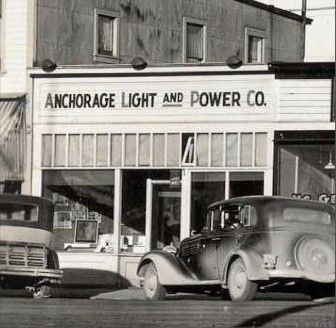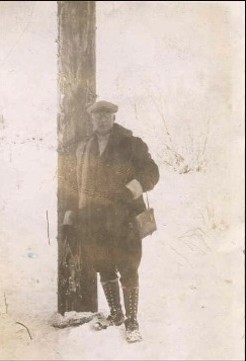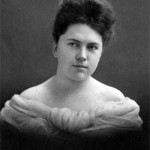Click here to print
The Man Who Filmed Early Anchorage
posted July 24, 2014
Little motion-picture documentation exists of life in pre-WWII Anchorage, Alaska, and far less from before 1930. The National Film Preservation Foundation has awarded a grant to Alaska Moving Image Preservation Association to look after some of the footage that has survived.

Eklutna Valley and Lake. Image: Anchorage Museum of History & Art
n
In the harsh climate and terrain of the 49th of the 50 United States of America, ensuring survival occupied much of the attention of every early transplant from “The Lower 48” who ventured up there.
Migration to the state picked up from the last years of the 19th century thanks to a series of gold rushes of which the Nome strike was arguably the largest — the better-known Klondike gold rush took place largely across the Canadian border, in the Yukon.
What swelled Nome from a small town in the state’s northwest to one of some 12,000 people was how readily prospectors found gold there: it literally scattered the beaches of Norton Sound on the Bering Sea.
Today, after fluctuations over the years, Nome is about one-third that size. It is Anchorage that has grown over the decades as a glacier should over millennia; it is by far the largest Alaskan settlement with about 40 percent of the state’s 700,000 residents; but its building did not begin until 1923. And the hardy souls who live through its harsh winters have a debt of gratitude to an industrious citizen of early Anchorage, Frank Ivan Reed, who lived from 1872 to 1944. Reed contributed in many ways to the progress of the Alaskan city, and he also left rare film of its early days — in fact, of its birth and infancy.
His engagement with Anchorage began after an already adventurous life. Raised in Council Bluffs, Iowa, he began his working life by moving to Nebraska for a job as an expressman ensuring safe passage of rail cargo. In 1898, he and his brother volunteered to fight in the Spanish American War, and then served in the Philippine American War – the Philippine War of Independence. Both contracted malaria, and while recuperating decided to try their luck in Alaska rather than return to Nebraska.
In 1900, they sailed north to join other “stampeders” lured to Alaska by the Nome gold rush. Reed struck one form of mother lode even before arriving there: on the sea voyage to the state, he met 16-year-old Pauline Hovey,a Munson, Ohio native who was traveling to Nome to manage a store her mother had invested in. They went to Seattle in 1904 to marry.
The Reeds lived in Nome until 1912 whilst Frank Reed worked for the Solomon Dredging Company, and then his family resided in Seattle whilst Reed moved to Talkeetna, in the south-central part of the state, to set up a gold-dredging operation. Business took Reed to Anchorage – on one occasion, he brought dredging equipment the 1,500 miles from Seattle by boat to Anchorage, by river barge up the Susitna River, and finally by horse train to the mines. Visits to Anchorage made Reed aware of preparations for a major civic project.

Reed with President Warren G. Harding in the Anchorage Hotel bus, 1923
In fact, Anchorage owes its existence to President Woodrow Wilson’s signing 1915 legislation that would ambitiously extend an earlier, short railroad in the south of the state up through Anchorage and beyond to Fairbanks in the interior or the territory. (Alaska would not become a state until 1959). Anchorage would serve as the base of operations for the Anchorage Engineering Commission.
So in 1915, Reed and his family moved to an Anchorage that was then barely a town. Its building had begun only the year before as a project of the U.S. federal government, and as an unusual sort of settlement, for Alaska: Other major towns sprung up for fishing or mining.
Once settled in the town, Reed invested in the Anchorage Lumber Company, a logging and sawmill concern that was supplying materials to the developers of the grand Anchorage Hotel. By the time construction was complete, it had bankrupted the builders. Unable to pay for the goods Reed had supplied, they cleared their debt by handing the hotel over to him. He remodeled it, and then lived in and operated it with his family until the mid 1930s.

Old Eklutna Power Station; Reed Collection
The project was colorfully characteristic of Alaska. In her 2002 report, The Early Electrification of Anchorage, Kristy Hollinger writes that the only land that the electricity authority had to buy was a 161.42-acre strip needed for the dam’s tailrace (channel below the structure). Acquiring it became easier once the land’s homesteader, William S. Myers, moved to alternative accommodation upon conviction for the murder of an employee of the electrical company.
Reed clearly had pull in the town. He had been on its first council in 1920, served as president of its chamber of commerce, built roads, and persuaded the fire department to switch from horse-drawn wagons to motorized engines firetrucks. But even with all that, it had taken him seven years to clear all the financing and authorization snaggles and be able to build a power plant, a dam to serve it, and the lines that would carry power to Anchorage. The project achieved remarkable engineering feats such as putting up 27 miles of pole and line in 90 days.

Original Anchorage Light & Power Company offices
That impressed even Reed — so much so that he decided to do something quite unusual: film it. And from there he took to recording other development projects in Anchorage and elsewhere in Alaska. The construction of the power station, which Reed owned until 1943, remained his most common subject, but he often filmed scenes at the Anchorage Hotel and of such major developments in Anchorage as the advent of the Alaska Railroad.
The Alaska Moving Image Preservation Association’s collection has those of Reed’s films, and many others. He also shot aerial views from an aircraft piloted by the pioneer bush pilot, Russ Merrill, who disappeared in 1929 and was honored by the naming of Anchorage’s first official airport in 1932 as Merrill Field. Reed had filmed Merrill in various situations, including as he took off and landed on Spenard Lake, which now forms part of the Lake Hood Seaplane Base complex, the busiest such air base in the world.
When Frank Reed died, he left behind the film now with the Alaska Moving Image Preservation Association. For Kevin N. Tripp, the group’s archivist, among the most compelling of the footage are images of family life. The Association’s application to the National Film Preservation Foundation noted “there is simply not a lot of motion picture documentation of life in pre-WWII Anchorage, and very little that is pre-1930.”

Frank Ivan Reed
So, says Tripp, the film provides rare views into Anchorage’s first years: footage of Reed family members outside their home, in the streets and alleys of Anchorage, arriving at Anchorage’s first hospital, and having a picnic on Anchorage’s Cook Inlet shore along with prominent early residents of the city.
The NFPF preservation award will allow the Alaska Moving Image Preservation Association to undertake preservation work on 6 of the 12 reels in the Reed collection. The recognition the award provides marks another step in the association’s struggle to remedy a situation that in the mid-1980s was dire. The group formed as fallout from drastic state budget cuts in 1986. Alaska’s moving image heritage, say Tripp and his colleagues, was jeopardized by the closure of many production facilities and sharply shrank staffing of others. Libraries, museums, and archives were hard hit, too. Core archival film, television, and audio reels and tapes were consigned to improper storage and remained there for years unprotected from heat, cold, and humidity, not to mention safe keeping.
In 1991, when jobs for them remained scarce, archivists and librarians organized AMIPA as a nonprofit organization and by 1997, with public and private donations, was able to switch from an all-volunteer group to one with a paid curatorial, technical, and administrative staff. In 2004, AMIPA formed a preservation partnership with the University of Alaska at Anchorage/Alaska Pacific University Consortium Library and moved into offices there, and the next year placed its collection of 17,000 items in proper film and magnetic-media vaults in the building.
— press release and research
Printed from Moving Image Archive News: http://www.movingimagearchivenews.org
URL to article: http://www.movingimagearchivenews.org/the-man-who-filmed-early-anchorage/
Click here to print

